Essays on the Marshallese Past
History and Archaeology of a B-24 bomber off
Ajola I., Majuro Atoll

|
Between November 1943 and January 1944 a number of U.S. aircraft did not return from their attacks on the Japanese bases in the Marshalls. Many crashed into the sea, while some could successfully make an emergency landing on one of the atolls. Such is the case with the B-24 described here.
The Wreck
The wreck of a B-24 aircraft rests on the lagoonal margin of the reef platform between Majuro ("Laura") Island and Ajola, in the northwestern corner of the atoll in 1 to 1.5m of water at low tide.
Present are the port wing, most parts of the starboard wing, the central fuselage section between the wings, and four engines. In addition, a number of small parts can be found scattered around the area. All propellers, with three blades each, can be seen in place save for those of the No1 engine, which has fallen off its mounting and is resting nose down in the sand. The tip section of the starboard wing is snapped off missing. One propeller blade has been removed from the plane and transported to the lagoonal entrance of Laura , where it is used as a reflective marker by night to indicate the location of the narrow pass.
Most of the fusalge of the plane has disappeared, probably due to the forces exerted on it by waves and tidal movements across the reefflat. No pieces of the cockpit, front machine gun or the entire rear fuselage including rear alierons could be located. Part of the fuselage, the bottom of the port section directly behind the wings is still extant.
Found were the Martin machine gun turret in front of the wing, and a Sperry Ball turret, the belly machine gun unit with one barrel of the machine guns still present on the rear of the wing.
The bottom of the lagoon shows a few isolated pieces of aluminium, among them parts on engine cowling some 20 metres behind the planeˆevidence of the rough landing.. Given the sediment in the area, it is very likely that other pieces are still buried in the sand.
The aluminium is on the whole in good condition. The wings, in particular, are strong enough to step on and seem to be used as walking platform by many fishermen. It can be expected that as long as no untoward actions happen, the plane will be around for some time.
Identity of the Plane
Based on historical records, the plane on the reef off Laura has been identified as a B-24J-CO "Liberator" bomber, Serial number #42-73013, manufactured by Consolidated Aircraft Corporation at its main production plant in San Diego. The Army Air Force had ordered a large number of these planes (Order No AC-30461) at a cost of US$ 241,924.00 each. The particular plane was delivered to the Army Air Force Modification Center in Tucson, Arizona, on 30 August 1943. The plane was then moved to the Hawaiian Air Depot, where it was received on 26 September 1943 under whose control it remained until 5 October 1943, when it was delivered to the 11th Bomb Group, VIIth Army Air Force. It would appear that the plane was put in active service by the VIIth AAF soon after.
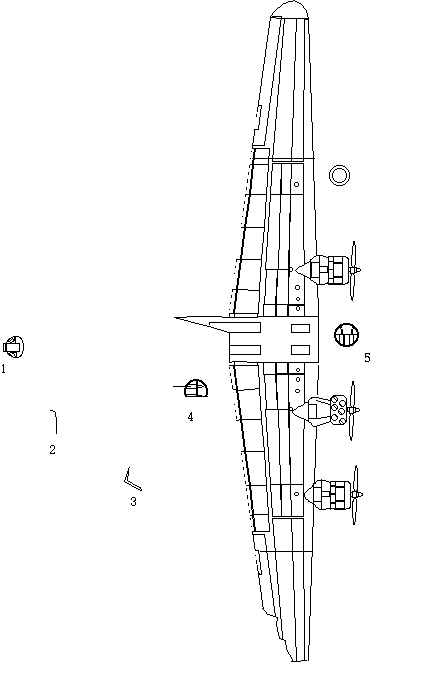
Plan of the extant remains of the B-24J "Liberator" bomber on the reef platform near Ajola, Majuro Atoll.

Wreckage of a B-24J "Liberator" bomber resting in shallow water off Ajola Island, Majuro Atoll. Top: Port wing. Note that engine no 1 has fallen off its mount. Bottom. Closeup of engine no4 and part of the starboard wing.


Wreckage of a B-24J "Liborator" bomber resting in shallow water off Ajola Island, Majuro Atoll. Close-up of the Sperry Ball Turret, resting on its right side, overgrown with coral.
Upon delivery to the 11th Bombardement Group (Heavy), the plane was assigned to the 431st Squadron. The 11th Bomb Group was headquartered in Funafuti, where also the 42nd and the 431st Bomb Squadrons were based. The other two squadrons of the 11th Bomb Group, the 26th and the 98th, were based on Nukufetau Atoll.
The 431st Bomb Squadron was at the time of the crash still stationed in Funafuti, Tuvalu, because the base in Tarawa, Kiribati, captured by U.S. Marines in late November 1943 had not yet been fully operational at the time. However, the planes of the 11th Bomb Group were staged through Tarawa on the day of the crash.
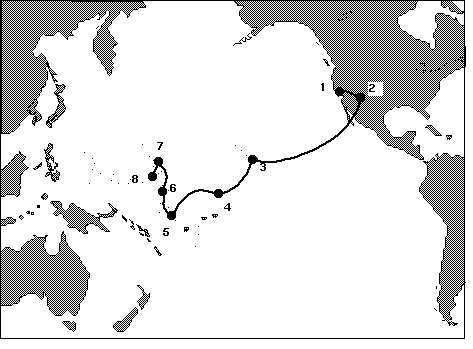
Route of the B-24 J #42-73013. 1¡Consolidated Factory, San Diego; 2¡ Army Air Force Modification Center, Tucson, Arizona; 3¡Hawaiian Air Depot; 4¡Canton Island Air Base; 5-Funafuti Air Base; 6¡Tarawa, Kiribati (refuelling); 7¡Taroa, Maloelap Atoll (target) 8¡Majuro Atoll (crash site)
.
From the production numbers and the date it appears that plane #42-73013 is one of the first B-24Jˆs to roll off Consolidated's San Diego plant. The aircraft is the 50th plane of the first prduction block of B-24Jˆs rolling out from the San Diego factory. Thus it was one of the few planes fitted with Consolidated A-6 tail turrets as nose nose, as opposed to the Emerson power turrets which were installed by Ford and later also by Consolidated.
It is unclear whether the particular B-24J (#42-73013) carried a nickname, but this is very likely given that apparently all other planes of the 431st squadron had such unofficial names.
Crew
According to the Missing Air Crew Report the crew on board of the ill-fated flight consisted of the following ten crew members: 1st Lt. Ivan M. Osborne, Pilot; 1st Lt. Raymond D. Cloyer, Co-Pilot; 2nd Lt. Virgil A. Tramelli, Navigator; 1st Lt. Maxie G. Deer, jr., Bombardier; T Sgt Edward J.Bislew, Engineer; T Sgt Joseph J.Perry, Radio Operator; S Sgt John J. Dell, Asst Radio Operator; S Sgt Warren C. Hill, Gunner; S Sgt Hulbert J. Swaim, Gunner; Pvt Williston F. Rumsey, Asst Engineer
Events leading to the crash
On 28 December a fateful combination happened: In total 15 B-24s of the 7th AAF from Funafuti, staged through Tarawa, and from Canton, staged through Baker, hit Japanese installations on Maloelap, Mile and Majuro. The B-24 which crashed on Majuro, therefore, drew the ire of the garrison of Maloelap as well as the Japanese caretakeers on Majuro. Both did not bide well for the U.S. downed airmen stranded on Majuro.
Aircraft #42-73013 had taken of from Funafuti, Tuvalu, headed towards Tarawa, Kiribati, where the squadron refuelled and then headed towards Maloelap. On the return leg the aircraft was scheduled to once again land in Tarawa for refuelling and then head back to Funafuti. The bombing mission encountered heavy clouds and intense fighter opposition over the target.
The B-24 sustained damage over Taroa. With two engines out of order it limped back towards Kiribati, making it as far as Majuro.
Given what was known about Majuro Atoll at the time, the U.S. Forces assumed that the sea-plane base on the eastern end of the atoll was still operational. Thus, Majuro had been repeatedly bombed in December 1943. In fact the sea-plane base had never been totally completed and at the time of the crash landing the construction unit, as well as the military stationed on Majuro had been transferred to Mile Atoll in November 1942 to construct the base there. In view of state of intelligence at the time, however, it was quite understandable that the pilot tried to land as far away from them as possible.
The crash landing was witnessed by two planes:
"At 0001Z [ local time, DHRS], 29 Dec 1943 I saw Lt Osborne make a crash landing on the reef in the northwest end of the lagoon of Majuro Atoll. The cause was the loss of two engines due to action by enemy aircraft in a bombing strike on Maloelap Atoll. As we left Maloelap #2 engine was hit and began throwing oil badly. A short time later #3 engine was hit and began smoking badly. It was then that Lt. Osborne left the squadron formation and headed for Majuro losing altitude all the time and indicating a speed of about 135 mph. We followed him down and watched him land. On the letdown #2 engine was feathered. He made a perfect landing but came to stop in about 100 feet. He was about a quarter mile out from a small island in water about 4-6 feet deep. Two Zeroes followed him down and one Zero made a pass at the plane in the water before we could chase him off. We passed the plane immediately after it stopped and could not see anyone getting out. The plane was not broken up and rested high in the water, most of the plane being visible. Due lack of ammunition and danger to our own airplane, we were not able to remain in the area." (Harvey T. Lundy, 2nd Lt Air Corps).
Upon leaving Majuro airspace a radio report on the crash landing was given, followed by a more detailed account upon return to the base in Tarawa, en route back to Funafuti. It appears from the limited data available, that the U.S. Navy promised to immediately sent a "dumbo" plane, a PBY Catalina Flying Boat to investigate and potentially rescue the crew, but failed to do so. A dumbo plane was finally dispatched on 2 January 1944, five days after the crash, to reconnoiter Majuro Atoll and to search for at the crashed plane. The mission report of that plane reads as follows:
"The plane arrived at the northwestern section of Majuro Atoll and found the B-24 as reported, lying on the reef about midway between the two islands which were about 400 yards apart. The plane was broken in two just off the trailing edge of the wing and was awash. The remaining 500lb bomb was dropped but fell about 25 yards short of the target. Several strafing runs were made and a total of about 430.50 cal and 200.30 cal ammunition fired."
The action to bomb the plane was taken in order to deny the enemy the use of the plane, or its armament for intelligence purposes and apparently was standard practice.
A B-24 returning from a strike against Taroa on 10/11 January 1944 observed that "red and green flares were fired from the ground at Majuro." It is unclear whether any actions were initiated. by the VIIth Bomber Command. We can assume that the U.S. airmen were, at that time, still on Majuro, unless, of course, flares salvaged from the aircraft were fired off as a ruse to entice the B-24s to come lower.
Events after the landing
According to oral history, the three Japanese present on Majuro (two traders and one construction official [the latter stranded there because of a B-24 attack on shipping]) ordered the Marshallese to take the American airmen to the Japanese administration building. There the Japanese ordered the Marshallese to beat the airmen. Informants mention that the Marshallese did so very reluctantly, but nonetheless did so for fear of being beaten and otherwise punished themselves.
From what can be reconstructed, some among the Marshallese were not prepared to join in, regardless of repercussions. Chiefly among them was Alexander Milne, a mission teacher who spoke English.
The Japanese also went to the plane wreck, or ordered the Marshallese to recover from the wreck a number of items, among them two 50 calibre machine guns (waist guns ?) with ammunition.
As far as the events on Majuro are concerend, we also have a more incidental account by Milne's daughter May Kalmen (then 12):
"On December 15, 1943, a Japanese patrol boat came to atoll of Majuro and took my father, "Alexander Milne away to Maloenlap Atoll, Ngata and Imata, the two Japanese officers in charge of Majuro Atoll at the time, told the Captain of the patrol boat to take Alexander to Maloelap or trial. Mr. Milne was accused of spying for the Americans. He was also blamed for conducting Sunday services, and his main fault that cost him his life, was, he could not be found at the time an American plane came down in the lagoon, to act as an interpreter.
The Japanese Actions
Given the highly centralised system of administration, we can safely assume that the Japanese representatives on Marshall Islands notified the headquarters at Kwajalein, which then decided on further action. Oral history has it that a a boat came to pick up the airmen. These, as well as at least one Marshallese, Alexander Milne, were then taken back to Taroa, Maloelap, the very base the plane had attacked.
Who was this Alexander Milne? A. Milne was born on 12 June 1904 in Ebon, the southern most atoll of the Marshall Islands, as son of James and Liomere Milne. A. Milne is listed by a U.S. Intelligence assessment of the Marshall Islands, which had been drawn up in August 1943, well before the U.S. landings in Kiribati, and is described as follows:
"Alexander Milne, the son of a Scotch-Gilbertese missionary father and a native mother, was born and reared in Ebon and educated at the mission school at Kusaie, where he taught for three years. He now lives on Majuro with his wife, a native woman of the upper class. He speaks both English and Marshall, and probably teaches at the church school at Majuro, where he held the post of evangelist"
Milne, as well as all others figuring in the manual, was listed there because the U.S. intelligence thought of him as a potential source of local information, knowledge and possibly co-operation with the landing U.S. forces. The Japanese had the same opinion of Milne and used the opportunity given by the rescue of the crew to rid themselves of a potential future threat.
Treatment of Prisoners of War
The offical way U.S. Prisoners of War were handled was to transport them to the headquarters of the 6th Base Force on Kwajalein Atoll, where they would be interrogated, and then ferried on to the Headquarters of the 4th Fleet in Chuuk (Truk). If the prisoners of war were captured on non-garisoned atolls, then transport from the nearest garrisoned atoll would be dispatched for pick up, and the Pow 's might be kept on the garrisoned atoll for some time until the next transport became available.
After the fall of Kwajalein and the interruption of surface shipping between the atolls of the
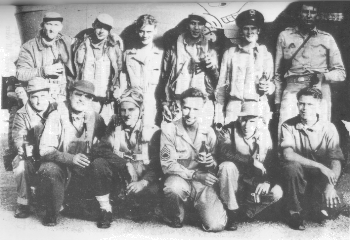
Photograph showing a previous crew of Lt. Ivan Osborne, flying a different B-24 aircraft ("Smokey Stover") Photo taken in late November 1943. Back row: Chadkowski (ground crew), Swaim, Dell, Perry, Deer, Osborne. Front row: Beysler (ground crew), Tramelli, Kline, Bislew, Hill, Lundy. This is the last picture of most of the crew. Not part of the crashed crew were the two ground crew members, as well as Kline and Lundy. (Photograph courtesy of Harvey Lundy).
Marshall Islands, as well as between the Marshalls and Chuuk, the captured U.S. airmen were held on the garrisoned atolls. At the end of the war, no PoWˆs were handed over. All were said to have died either from the wounds obtained during the crash, or dring U.S. air attacks when their bombshelters were destroyed. These claims were often hard to disprove, but in a number of instances this was possible, and war crimes trails were held.
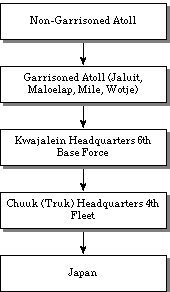
Official line of transfer of U.S. Prisoners of War before the U.S. occupation of Majuro Atoll
The execution of downed U.S. airmen was unfortunately rather common in Micronesia, although this contravened the stipulations of the Geneva Convention. Following surrender the U.S. forces conducted investigations and the military trials to punish the offenders. In the Marshall Islands we have evidence for such actions from Jaluit Atoll and Eneen-Kio (Wake Island).
The ultimate fate of the airmen could not be ascertained, but it would appear that they perished in the U.S. assault on Kwajalein in February 1944.
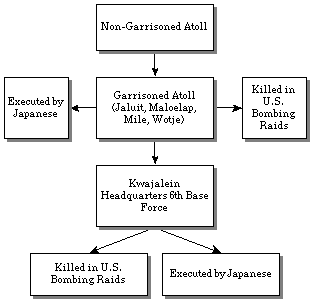
Actual fate of U.S. Prisoners of War in the January and February 1944 immediately before and during the U.S. occupation of Majuro and Kwajalein Atolls


Bibliographic citation for this document
Spennemann, Dirk H.R. (1998). Essays on the Marshallese Past Second edition.
Albury:
URL: http://marshall.csu.edu.au/Marshalls/html/essays/es-ww2-8.html

CONTACT:
Dirk H.R. Spennemann,
Institute of Land, Water and Society,
Charles Sturt University, P.O.Box 789,
Albury NSW 2640, Australia.
e-mail: dspennemann@csu.edu.au

| select from the following... |
|
|
|
|
|
|
|
|
|
|
|
|
|
|
|
| |
|
|









